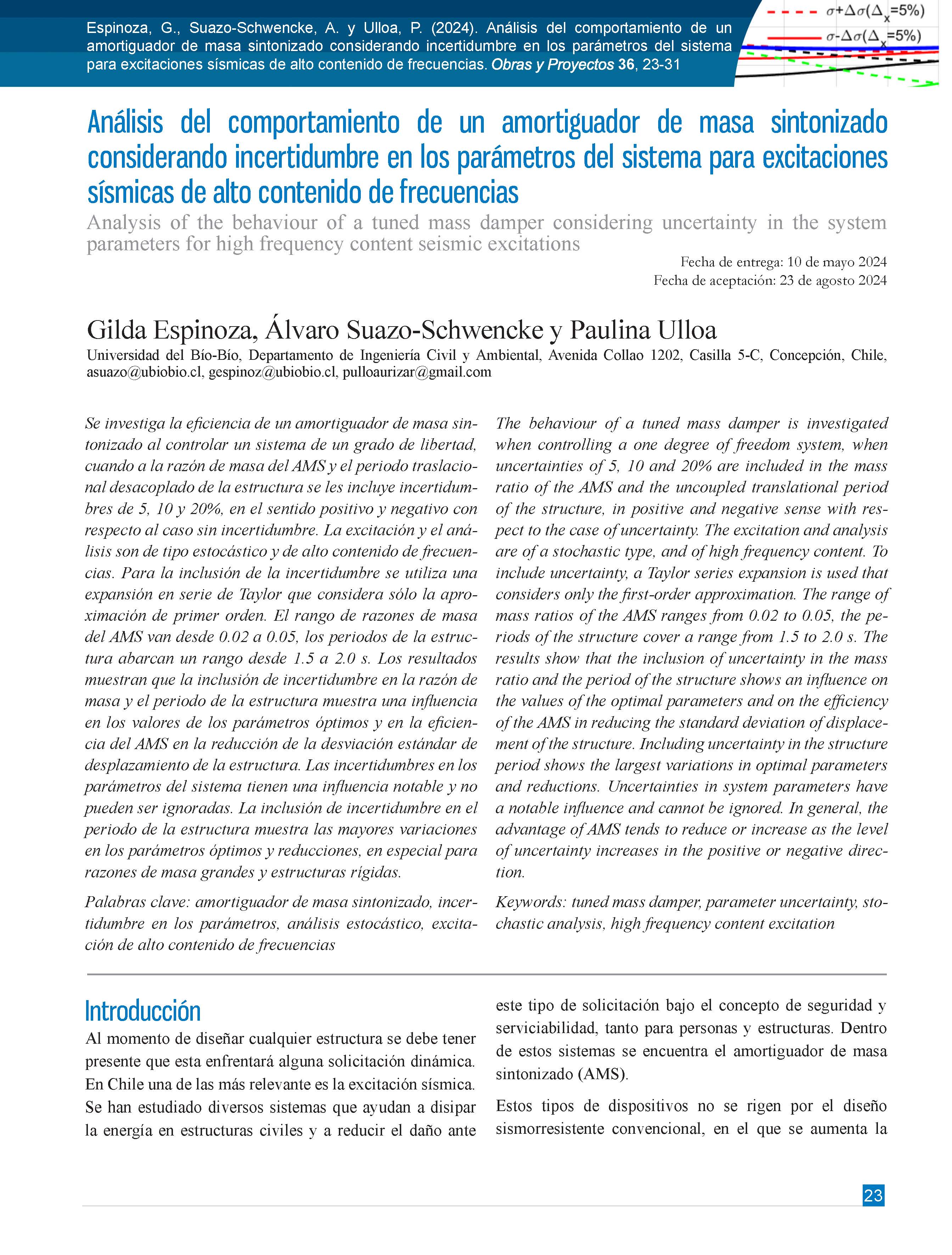Analysis of the behaviour of a tuned mass damper considering uncertainty in the system parameters for high frequency content seismic excitations
DOI:
https://doi.org/10.21703/0718-2813.2024.36.3000Keywords:
Tuned mass damper, Parameter uncertainty, Stochastic analysis, High frequency content excitationAbstract
The behaviour of a tuned mass damper is investigated when controlling a one degree of freedom system, when uncertainties of 5, 10 and 20% are included in the mass ratio of the AMS and the uncoupled translational period of the structure, in positive and negative sense with respect to the case of uncertainty. The excitation and analysis are of a stochastic type, and of high frequency content. To include uncertainty, a Taylor series expansion is used that considers only the first-order approximation. The range of mass ratios of the AMS ranges from 0.02 to 0.05, the periods of the structure cover a range from 1.5 to 2.0 s. The results show that the inclusion of uncertainty in the mass ratio and the period of the structure shows an influence on the values of the optimal parameters and on the efficiency of the AMS in reducing the standard deviation of displacement of the structure. Including uncertainty in the structure period shows the largest variations in optimal parameters and reductions. Uncertainties in system parameters have a notable influence and cannot be ignored. In general, the advantage of AMS tends to reduce or increase as the level of uncertainty increases in the positive or negative direction.
References
Brock, J.E. (1946). A note on the damped vibration absorber. Journal of Applied Mechanics 13(4): A284. doi.org/10.1115/1.4009588
Crandall, S.H. and Mark, W.D. (1963). Random vibration in Mechanical Engineering. Academic Press, New York, US.
Debbarma, R., Chakraborty, S. and Ghosh, S. (2010). Optimum design of tuned liquid column dampers under stochastic earthquake load considering uncertain bounded system parameters. International Journal of Mechanical Sciences 52(10): 1385-1393. doi.org/10.1016/j.ijmecsci.2010.07.004
Den Hartog, J.P. (1940). Mechanical vibrations. McGraw-Hill, New York, US.
Espinoza, G., Saavedra, J., Gajardo, K., Suazo, A. y Cifuentes, C. (2021). Eficiencia de un amortiguador de columna de líquido sintonizado considerando una excitación sísmica de alto contenido de frecuencias e incertidumbre. Obras y Proyectos 29: 67-79. doi.org/10.4067/S0718-28132021000100067
Espinoza, G., Sagredo, G. y Suazo, A. (2020). Análisis de la eficiencia de un amortiguador combinado sintonizado con incertidumbre en los parámetros sometido a una excitación sísmica de alto contenido de frecuencias. Obras y Proyectos 28: 58-67. doi.org/10.4067/S0718-28132020000200058
Frahm, H. (1909). Device for damping vibrations of bodies. US Patent No. 989958A.
Miranda, J.C. (2005). On tuned mass dampers for reducing the seismic response of structures. Earthquake Engineering & Structural Dynamics 34(7):847-865. doi.org/10.1002/eqe.461
NCh2745 (2013). Análisis y diseño de edificios con aislación sísmica. Instituto Nacional de Normalización INN, Santiago, Chile.
Ormondroyd, J. y Den Hartog, J.P. (1928). The theory of dynamic vibration absorber. Transactions of the ASME 50(7): 9-22. doi.org/10.1115/1.4058553
Shum, K.M. (2009). Closed form optimal solution of a tuned liquid column damper for suppressing harmonic vibration of structures. Engineering Structures 31(1), 84-92. doi.org/10.1016/j.engstruct.2008.07.015
Sladek, J.R. and Klingner, R.E. (1983). Effect of tuned‐mass dampers on seismic response. Journal of Structural Engineering 109(8): 2004-2009. doi.org/10.1061/(ASCE)0733-9445(1983)109:8(2004)
Soto‐Brito, R. and Ruiz, S.E. (1999). Influence of ground motion intensity on the effectiveness of tuned mass dampers. Earthquake Engineering & Structural Dynamics 28(11): 1255-1271. doi.org/10.1002/(SICI)1096-9845(199911)28:11<1255::AIDEQE865>3.0.CO;2-C

Downloads
Published
Issue
Section
License

This work is licensed under a Creative Commons Attribution-NonCommercial 4.0 International License.







